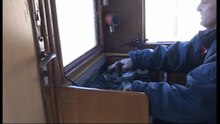Mylius gearbox
The Mylius gearbox was a compact, mechanical, semi-automatic gearbox that was mainly used in light internal combustion railcars with a drive system. It was suitable for smaller engines with an output of 50 kW to 135 kW.
history

The gearbox was developed by Otto Mylius (1887–1941) and built by the Deutsche Getriebe GmbH in Berlin, which he founded. It was used for the first time in 1932 on the two-axle railcars of the DR 720 to 722 series. This gearbox quickly proved itself for small combustion railcars - among other things, it was used in large numbers in the railcars of the DR 135 061… 132 series. After the Second World War, it was continued to be built at Voith in Heidenheim, VEB Getriebebau in Leipzig and Tatra Kopřivnice until the early 1960s . Apart from the general mechanical wear of the gears, the Mylius gear was not free from wear due to incorrect operation due to the subordination of the compressed air-switched reversing gear . It was therefore replaced by automatic transmissions , the most elegant of which is the differential converter transmission . The weight is given as 195 kg for a four-speed manual gearbox and 265 kg for a downstream reversing gearbox.
Structure and mode of operation
As with the previously used semi-automatic Soden transmission , the gears are not shifted directly by the driver, but only preselected, regardless of whether the railcar is stationary or moving. The preselected gear is transmitted to the gearshift shaft integrated in the transmission via cables and bevel gear. The actual switching process is carried out automatically after releasing the pneumatically operated single-disk dry clutch by shifting the mechanically interlocked shift rods, whereby first the dog clutch of the previously selected gear is released by pulling back from its shift rod. Then, in contrast to the Soden gearbox, the speeds of the claw clutches to be connected are synchronized by friction cones and then the claw couplings of the synchronized shafts are connected. The pneumatic engagement of the single-plate dry clutch completes the shifting process.
The direct shifting processes such as synchronizing and moving the shift rods are also carried out pneumatically in rail vehicles under a pressure of up to five bar; there should also have been transmissions with hydraulic controls. If the distance between the gearbox and the driver's cab was greater, the control movements of the selector shaft to select the selector rods and to lock them were also carried out electrically.
literature
- Heinz R. Kurz: The railcars of the Reichsbahn types . EK-Verlag, Freiburg 1988, ISBN 3-88255-803-2
Web links
- Photo of an open Mylius gearbox on the T 42 of the Bruchhausen-Vilsen Museum Railway
Individual evidence
- ^ Hans Christoph Graf von Seherr-Thoß: Köllmann, Gustav. In: New German Biography (NDB). Volume 12, Duncker & Humblot, Berlin 1980, ISBN 3-428-00193-1 , p. 323 f. ( Digitized version ).
- ↑ a b c d Heinz R. Kurz "The railcars of the Reichsbahn-Bauarten" EK-Verlag Freiburg, 1988, ISBN 3-88255-803-2 , page 42
- ↑ Heinz R. Kurz "The railcars of the Reichsbahn-Bauarten", EK-Verlag Freiburg, ISBN 3-88255-803-2 , page 142
- ↑ a b Design of vehicle transmissions , page 32
